Petra Jordan Travel Guide – Petra Temples, Petra Hikes + Petra Tips
For most people, visiting Petra’s ancient rock-hewn city is the highlight of their Jordan itinerary. This monster Petra guide will help you get the most out of your visit to Petra. Learn about the best Petra temples and Petra hiking trails, check out the Petra map and read my top 15 tips to visit Petra, including how to avoid the dreaded crowds. Even better, I’ve included my Petra itinerary to show you how to see all of Petra’s highlights in just two days without rushing.
Petra has been on my bucket list since I first saw evocative images of the Treasury peeking out through the narrow siq entrance. I’ll admit that I had totally built Petra up in my mind, and was a little concerned that reality might not match my expectations. However, I wasn’t disappointed at all, not one iota. To the contrary, Petra actually exceeded my expectations.
I think this is down to two factors. Firstly, there’s oh so much more to Petra than the famed Petra Treasury and Monastery (as ah-mazing as they are). The Petra Archeological Park is absolutely littered with architectural gems from temples to tombs to theatres.
Secondly, Petra is a first rate hiking destination. The ancient city has surreal desert landscape and many trails off the main path including some climbs with spectacular views.
We also really loved our Petra hotel, the Old Village Resort, which is kinda like staying in a luxe cave! See Tip 12 for more details.
Ahh … What is Petra?
Petra was the capital of the Nabataean Kingdom from around the 4th century BC. However, earthquakes in 363 and 551 AD largely destroyed the city. For centuries, Petra was lost to all but the local Bedouin tribes until being discovered by a British explorer in 1812.
As you’ll discover, Petra is remarkably well preserved. It’s full of architectural gems like the famed Treasury and Monastery, a Roman theatre, extravagant tombs, a colonnaded street, plus many temples and other structures.
Petra Map and Information
When you arrive at Petra, you’ll be given a good map (see photo below). The map shows the key sites and trails, along with walking distances, times and difficulty. The back of the map summarises the history of Petra and includes pictures and a short description of the key sites.
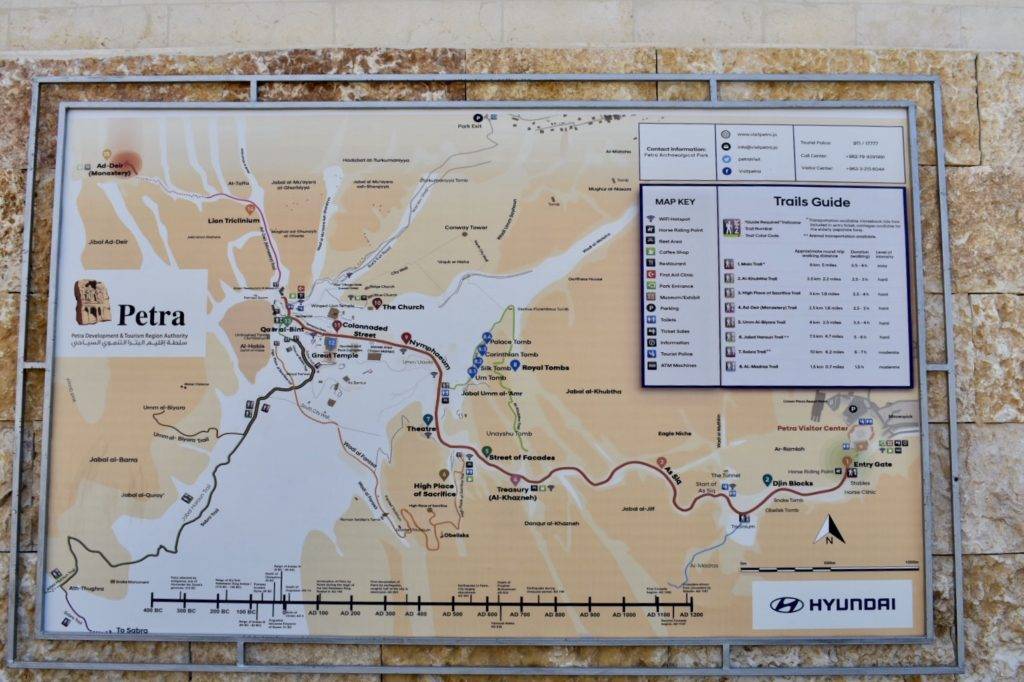
We also carried our handy Lonely Planet Jordan travel guide around Jordan. Along with the map and signs around Petra, the Lonely Planet info was plenty for us. If you want a more detailed immersion in the history and sites of Petra, you can also join a tour or hire a guide. See Tip 8 below.
Best Petra Temples, Tombs and Buildings
We easily covered all of the Petra temples, tombs and structures below in two days in Petra. The sites below are roughly in the order they appear on the map above, although some are along side trails.
You’ll also pass a myriad of other rock hewn structures as you make your way through Petra, particularly if you venture off the Main Trail. It’s pretty spectacular how many ruins there are outside the famous Petra Treasury and Petra Monastery.
The Siq and the Petra Treasury – Al-Khazneh
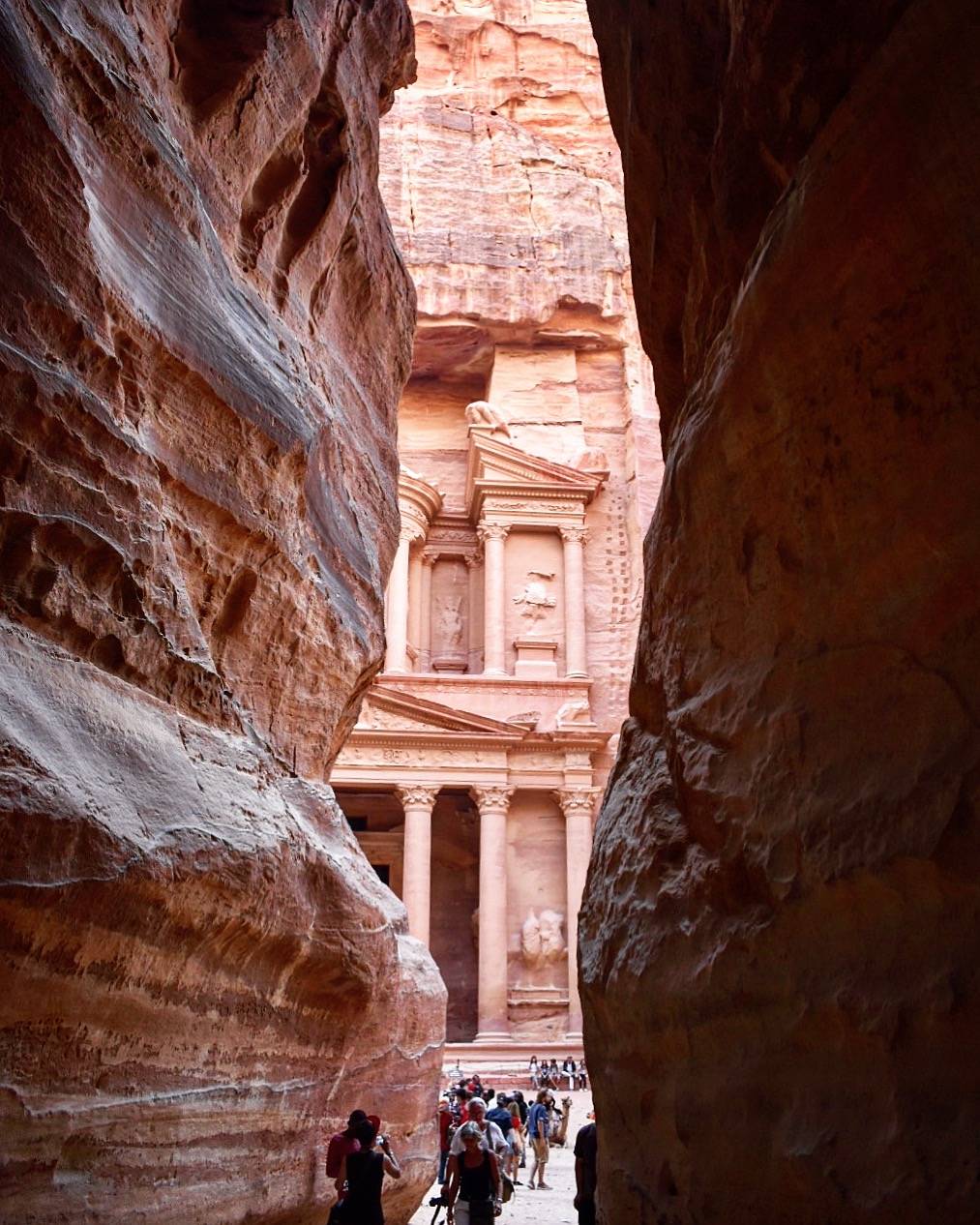
The Siq is the 1.2km narrow canyon leading into Petra with soaring rock sides. Look out for rock carvings and structures as you walk through. I think it was only on our fourth trip through the Siq (you enter and exit through it) that we finally deciphered the camel caravan relief!
The Siq is rambling with tourists, horses and horse-drawn carriages. If you go outside peak hours (see Tip 5 below) you might just be lucky enough to have a section of Petra’s atmospheric entrance all to yourself.
The Siq opens into the dramatic entryway to the Treasury (Al-Khazneh), which is probably Petra’s most famous image. For me, it was just as spectacular as I imagined as the Treasury slowly materialised with iconic camels resting in front of it. Photographic evidence above!
The Treasury dates from around the 1st century BC. It’s a facade (a spectacular one at that) so you can’t enter the structure. (Despite what Indiana Jones may have led you to believe.)
You enter and exit Petra via the Siq and Treasury. Visit at a couple of different times of the day to enjoy the different shades of colour and light.
Petra Street of Facades
The Street of Facades is a row of Nabatean tombs carved into the rocks. You pass the Street of Facades as you venture further into Petra beyond the Treasury.
The Facades are not one of Petra’s most famous monuments, but were one of my favorite sites that I kept returning to marvel at. Understated, unique and unexpected. See Tip 3 below for a photo of the Street of Facades.
The High Place of Sacrifice
The High Place of Sacrifice was a religious site on a high mountain. The main reason to visit the High Place is for the sweeping views of the ancient city below. Be warned, there’s a steep climb to get there, but the reward is 100% worth the effort.
The Theatre
The Theatre is a Nabatean theatre along Petra’s Main Trail. At first blush, it may seem like other theatres you see around Jordan (like the Roman Theatre in Amman), but there’s something pretty special about Petra’s Theatre. It’s the only theatre in the world that is carved into the rock, rather than built out by rock.
Royal Tombs
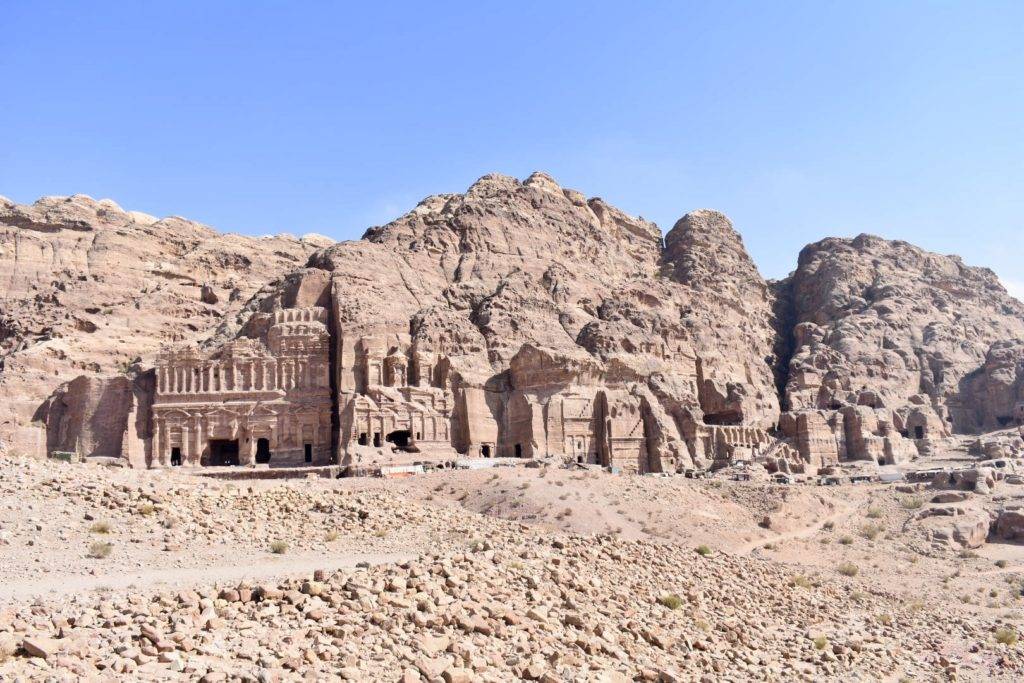
The Royal Tombs are four magnificent tombs just to the right of the Main Trail – Urn Tomb, Silk Tomb, Corinthian Tomb and Palace Tomb. Petra’s Royal Tombs are remarkably well preserved, and you can even go inside a couple of the rooms.
Colonnaded Street and the Great Temple
The Colonnaded Street is a street along the Main Trail lined by crumbling columns. It leads to the Great Temple which is one of the biggest monuments from the ancient city.
Believe it or not, the Great Temple was only uncovered in 1993, with excavations continuing for years after that. Makes you wonder what other architectural wonders are still hiding beneath Petra.
Petra Church
Petra Church is a small Byzantine church from around the 5th Century AD, and is only a few hundred metres off the Main Trail.
The Church is worth visiting for two reasons. Firstly, there’s some lovely mosaics on the Church floor. (If you like mosaics, don’t miss Madaba in Jordan.)
Secondly, ancient papyrus scrolls were uncovered in the Church, having been preserved after being carbonised in a fire. Petra Church was also discovered in modern times (1990s) and the scrolls are still being translated.
Petra Monastery – Ad-Deir
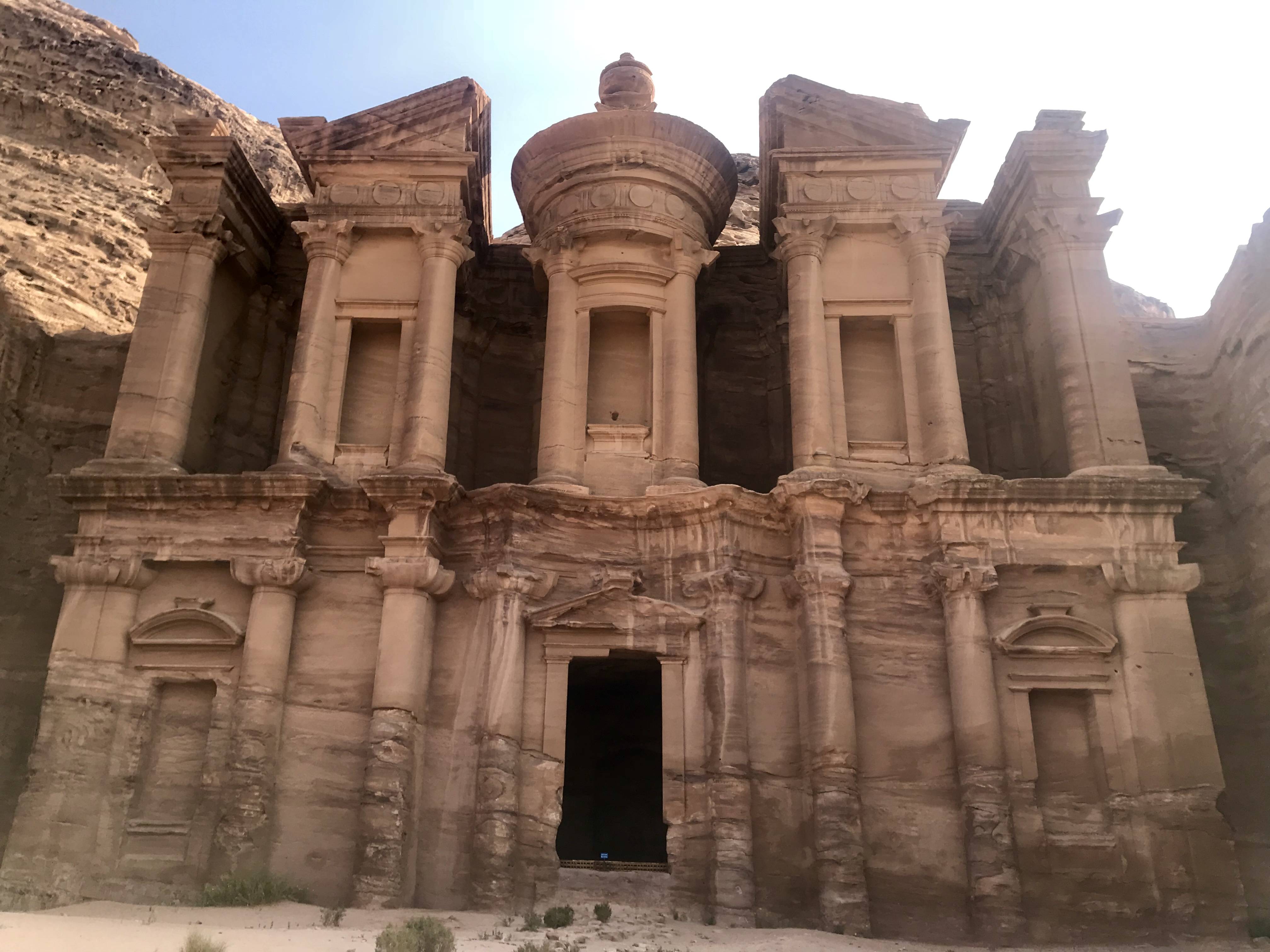
The Monastery (Ad-Deir) is Petra’s second most famous monument, and is surprisngly bigger than the Treasury at 48m high. As you may have guessed from its name, the Monastery was used for religious purposes by different religions throughout the century. Like the Treasury, the Monastery is a facade so you can’t enter it.
There’s a steep but not too long hike to get to the Monastery (see below). If you only do one walk off the Main Trail, this should be it.
Best Petra Hiking and Petra Trails
As you’ll see from the map above, Petra is lined with walking trails. As well as the Main Trail, you should aim to do the Monastery Trail plus at least one of the side trails for less crowds and epic views over Petra.
We walked the first four Petra trails below over our two days in Petra, which are the red, green, pink and orange trails on the map. There’s a few other trails on the main map of up to 10km each which I would love to have conquered if we had a couple more days in Petra.
If you love hiking, then I recommend that you also add Dana Biosphere Reserve to your Jordan Itinerary. We spent two nights hiking at Dana, and if there’s one thing I could change about our Jordan trip, it would have been to spend more time in Dana.

Petra Main Trail (Red Trail)
Distance and Difficulty: The Petra Main Trail is 8km / 5 miles return from the Visitors Centre. Easy walk, largely flat. Allow 3 – 4 hours return, including time to see the sites along the way. If you are walking the length of the Main Trail without stopping, it will take roughly 1 hour from the Visitors Centre to the start of the Monastery Trail at a reasonable but not cracking pace. On our second day, it took us 30 minutes from the Visitors Centre to the Treasury and then 30-40 minutes from the Treasury to the start of the Monastery Trail.
Trail Description: Most people who visit Petra do the Main Trail and often the Monastery Trail (sometimes with the help of a donkey!). The Main Trail is your entryway to Petra. You’ll travel through the soaring Siq gorge, marvel at the Treasury, pass the Street of Facades, the Treatre, the Colonnaded Street and the Great Temple, and can take easy side trips to the Royal Tombs and the Church.
Petra Monastery Trail – Ad-Deir (Pink Trail)
Distance and Difficulty: The Petra Monastery Trail is 2.5km / 1.6 miles return from the end of the Petra Main Trail (4km in). Medium walk, steep with lots of stairs, but not too long (in my opinion, the Petra map says hard). Allow 2 hours return from the start of the Petra Monastery Trail, or 2.5 – 3 hours if you walk a bit slower or want to linger at the Monastery. The one way uphill walk to the Monastery took us just over 40 minutes, including with two drinks breaks.
Trail Description: At the end of Petra’s Main Trail, you can continue on to the Ad-Deir (Monastery) Trail to see (obvs) the Monastery. The trail is steep and uphill, but there’s plenty of stalls along the way to stop for a drink or purchase a souvenir, and the distance isn’t too long. There’s also some great views along the way.
Al Khubtha Trail (Green Trail)
Distance and Difficulty: The Al Khubtha Trail is 3.5km / 2.2 miles return. Medium to hard walk, some steep sections. Allow 2 – 3 hours return, including time to view the Royal Tombs and soak up the epic views of the Treasury below.
Trail Description: The Al Khubtha Trail is off the Main Trail to the right shortly after the Theatre. The trail goes past the Royal Tombs and then heads steeply uphill. Slightly hot and sweaty walking, but you’ll be well rewarded at the top with spectacular views over the Treasury below. It’s definitely worth buying a drink at the little ‘cafe’ at the top, so that you can cool off and take the quintessential Petra photo (provided you’re not afraid of heights!). See Day 1 of our Petra Itinerary below.
High Place of Sacrifice Trail (Orange Trail)
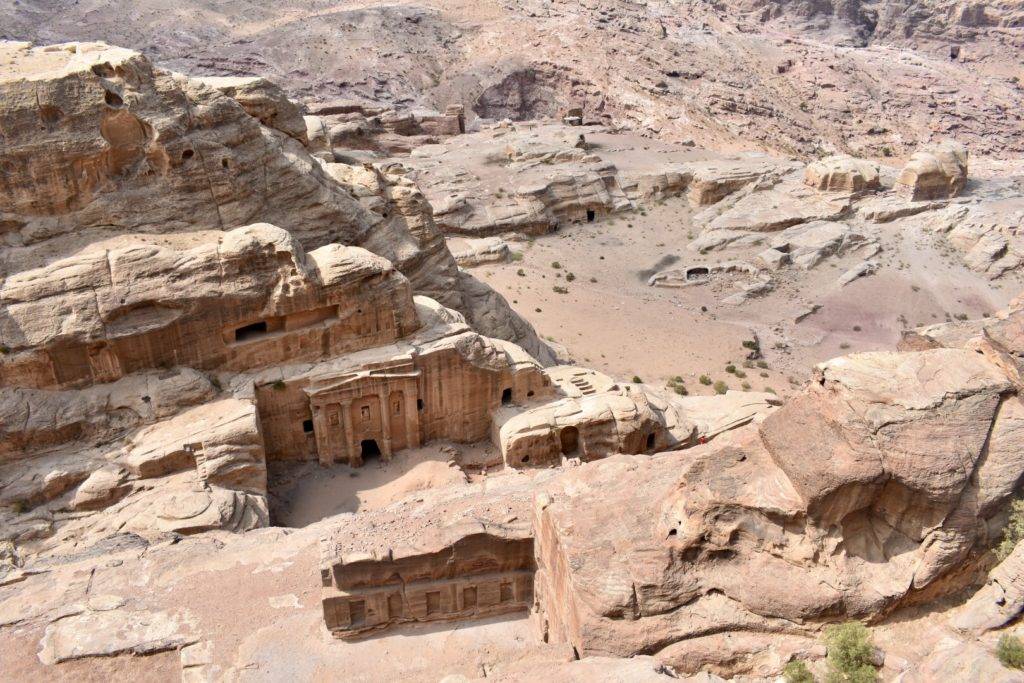
Distance and Difficulty: The High Place of Sacrifice Trail is 3km / 1.9 miles one way. Hard walk, many steep sections. Allow 2 – 3.5 hours one way, including time to rest and view the sites, or longer if you are a slower walker. (Note: Petra map says allow 3.5 – 4 hours).
Trail Description: The High Place of Sacrifice Trail is a one way trail that bypasses much of the Main Trail and gives you the best broad views over the ancient city below. The trail starts shortly before the Theatre and ends near the start of the Monastery Trail. The High Place of Sacrifice Trail is one way so can be walked in either direction. Walk the Main Trail in the other direction.
Little Petra to Monastery
Distance: 8km / 5 miles one way. We visited Little Petra but did not have time for this hike, so I can’t comment on the difficulty.
Trail Description: The hike from Little Petra to the Monastery is often referred to as Petra ‘through the back door’. The hike starts from Little Petra which is around 15 minutes drive from Petra. After reaching the Monastery, you could then do the Main Trail in the opposite direction, and end at the Visitors Centre.
The Little Petra trail is a good option for those who want to do a one way walk and are not self-driving (as you’ll start and end in different places). Most people explore Petra from the Visitors Centre, which requires you to retrace the same bath pack. But, it is a spectacular path, and we were very happy to retrace it three times during our visit!
Jordan Trail – Dana to Petra Trek
Distance and Difficulty: Epic 4 day hike over 70km. Hard to very hard.
Trail Description: The Jordan Trail is an epic cross-country hike from Um Qais in Jordan’s north to Aqaba in Jordan’s south. The full trail is over 600km and takes around 40 days. You can also do parts of the Jordan Trail. One of the most beautiful sections is said to be the Dana to Petra hike (or vice versa). At 70km and 4 days, this would be perfect if you want a longer and more challenging hike, and have a bit of time up your sleeve.
Top 15 Tips to Visit Petra Jordan
1. Best Time to Visit Petra and Petra Weather
Like most of Jordan, the best time to visit Petra for good weather is March to May (spring) followed October to November (autumn). However, surprise surprise, these are also the peak tourist seasons, in particular spring. We visited in October which was still hot during the day (but bearable even in the heat of the day) and fairly cool at night.
Summer (June to August) can get stifling hot, and winter (December to February) can be bitterly cold.
Like other parts of Jordan, Petra can be subject to flash flooding. Jordan experienced flash floods in November 2018 (the month after we visited). These floods resulted in casualties elsewhere in Jordan and the evacuation of thousands of tourists in Petra.
2. How to Get to Petra
Jordan’s a pretty compact country and is great for self-driving. (See my Jordan Travel Tips for more info.) Petra is very accessible from other places in Jordan that you are likely to visit. Petra is only 3 hours drive from Amman, 1.5 hours drive from Wadi Rum, 1 hour drive from Dana or 3 hours drive from the Dead Sea.
3. Getting Around Petra
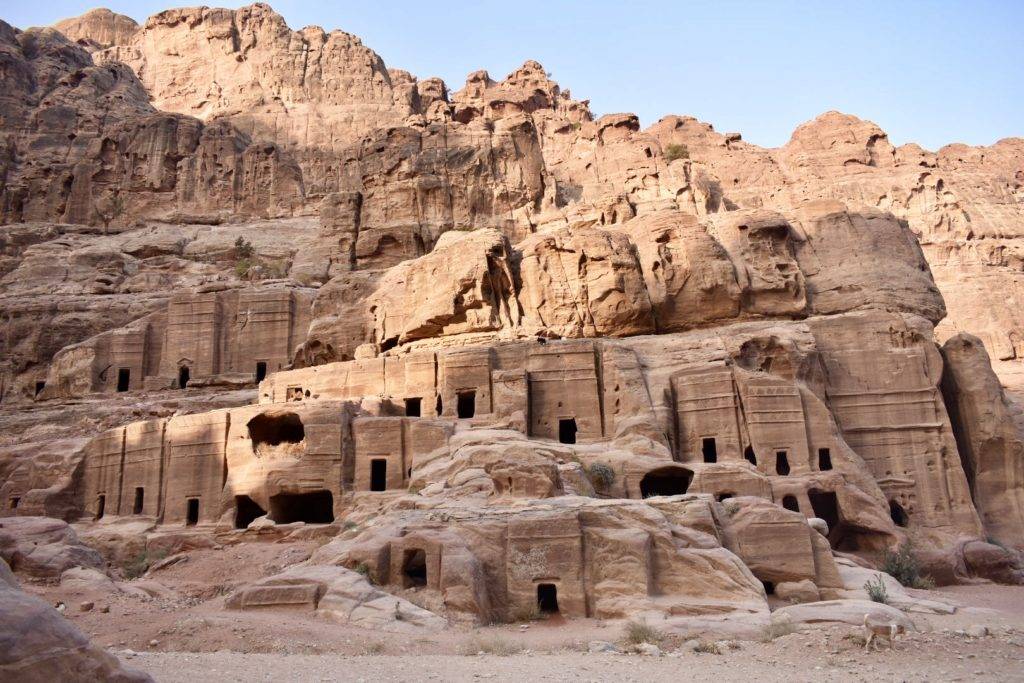
Street of Facades
I recommend walking around Petra, as that’s a big part of the fun and experience. However, if you have mobility issues, are exhausted, or simply prefer not to walk, then there’s various animal-powered transportation options to get you around.
Ticket price includes a horse ride to and from the start of the Siq, although tipping is expected. You can also get a horse drawn carriage down the Siq, camel rides around the Main Trail, and donkey rides to pretty much anywhere, including up the steep tracks like the Monastery.
Treatment of the animals in Petra was mixed, and in some cases downright cruel. I personally was not comfortable with it (and besides, I love walking), but will leave you to make up your own mind. If you witness animal cruelty, take a note of the horse’s number or any other details and report it.
4. How Many Days in Petra?
I recommend that you allow two full days (and preferably 2 nights) to do Petra justice and avoid the temptation to rush. It is possible to see all of Petra’s highlights in two days at a comfortable pace if you enjoy walking. (See our 2 day Petra itinerary below).
However, you could easily spend three, four or even five days on your Petra tour if you wanted to walk more of the trails, take time to relax, or simply lurve architecture and ancient civilisations.
You can squeeze Petra into one day, but it will be a big day. If time’s tight, I would absolutely without a doubt spend just one day in Petra rather than missing it. I would not, however, recommend taking a day trip from Amman. At 3 hours drive each way, this is a little too ambitious in my book!
We spent two days in Petra and visited Little Petra on the third day. During this time, we walked the Main Trail, two side trails, the Monastery hike and did Petra by Night. (Around 35km hiking all up!)
We met some people who only had one night in Petra and managed to squeeze in the Main Trail, one side trail, the Monastery and Petra by Night. Phew! They did say that they were so exhausted from a long day walking that they didn’t really feel like heading back in for Petra by Night, which detracted from the experience.
5. How to Avoid the Crowds at Petra
There’s three main ways to avoid the crowds at Petra. Firstly, consider travelling outside the peak March to May period. The second peak season is October to November. If you really want to beat the crowds and can handle the heat, you could visit Petra in June or September.
Secondly, avoid arriving at Petra during the peak hours of 8am-10am. Most tours arrive at Petra at around 8am. Start your day at Petra either very early (opens from 6am, although may still be dark then) or in the early afternoon after the tours are dispersed inside Petra or have finished for the day.
Finally, hot step it off the Main Trail and explore some of the incredible hiking on the side trails above. In my opinion, this is the best way to avoid the crowds. Let’s face it, most people either don’t have time to explore the side trails or don’t have the fitness (or perhaps enthusiasm) required.
That said, Petra wasn’t actually as crowded as I expected. The crowds were nothing compared to (less impressive!) ancient ruins we’ve visited in Europe.
6. What to Wear in Petra
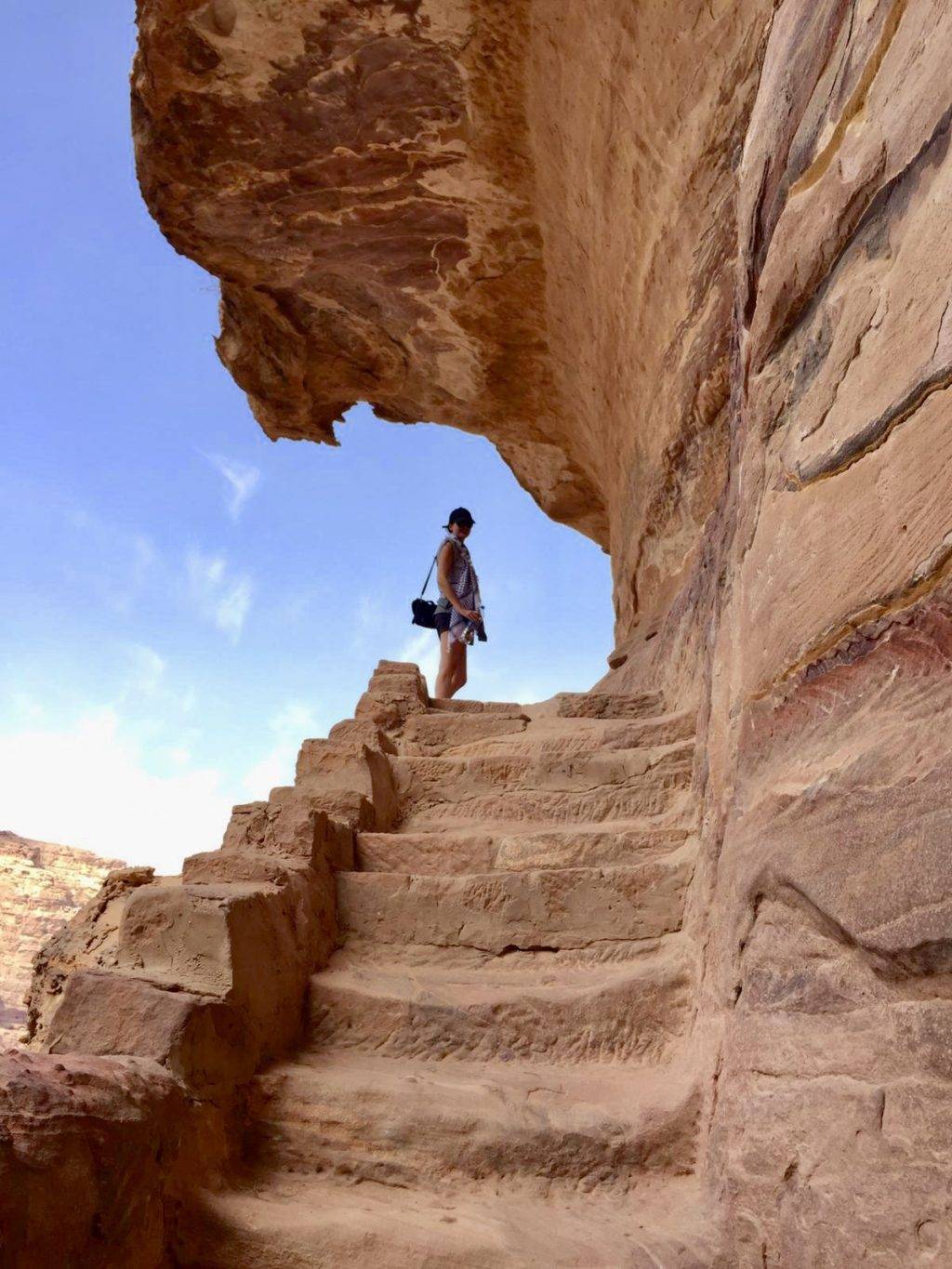
Place of High Sacrifice Trail
Your Insta-pics might look magical if you’re wearing a long flowing dress. However, your feet and clothing will thank you if you go for something slightly more practical. I wore regular hiking clothes to Petra – leggings or shorts with a t-shirt and a scarf as a cover-up.
In other parts of Jordan I wore loose clothing and always had my knees and shoulders covered, but I felt pretty comfortable in Petra in shorts. Plus, the days get pretty hot, so I was happy to let my legs breath.
Hiking shoes with good tread are an absolute must if you want to explore Petra’s side trails. We hiked 35km over two days (after doing over 20km hiking in Dana). Even then I had sore little feets at the end.
While I may not have looked even remotely trendy, I was quietly patting myself on the back when I was confidently navigating the rocky terrain like a mountain goat (okay, more liked a less sure-footed slightly clumsy baby giraffe) and brushing the dust off my active wear.
7. Petra Entrance Fee
The Petra ticket is included in the Jordan Pass, which is well worth getting. If you don’t have the Jordan Pass, Petra is JD50/55/60 for a 1/2/3 day pass.
Petra by Night is an additional JD17, including if you have the Jordan Pass. You need a valid day ticket to visit Petra by Night, so make sure you also get to Petra for at least the afternoon to make it worth the money.
If you visit Petra on a day trip from the border (e.g. from Israel or off a cruise ship) and do not stay overnight in Jordan, you’ll need to fork out a hefty JD90 for your ticket.
8. Petra Tours and Guides
We personally didn’t feel like we needed a guide for our Petra tour. It is very easy to find your way around and there’s plenty of information available. We were happy with the Petra Map that all visitors receive, the signposts around Petra, and the additional information in our Lonely Planet Jordan travel guide.
You can also download the new Visit Petra app which is filled with helpful info for your trip, and check out the Visitors Centre (13 below).
However, if you want a Petra tour guide, then it’s very easy. You have two options. Firstly, you can book a group tour in advance, either through your local accommodation or online through TripAdvisor or another provider. Secondly, you can hire a private guide. It’s easy to pick up a private guide at the entrance to Petra, or again you can book one in advance.
9. Food and Drink
You can either bring food and drink with you into Petra, or purchase everything you need in Petra. Petra is like a little village and is filled with stalls selling cool drinks and basic food, plus souvenirs and knick knacks like magnets, scarves and ornaments. You’ll need lots of water to avoid dehydration with the heat and long walks.
Since we were doing a lot of walking, we decided to only carry our initial supply of water to lighten our backpacks. If you’re on a budget, I recommend bringing a packed lunch, water and sports drinks. Water in Petra costs around 1JD and non-water drinks were usually 2JD, but up to 4JD in a couple of places – mainly the hilltop cafes with stunning views, where it’s totally worth buying a drink for the views.
We were regularly parched and downed a LOT of water and sports drinks (plus a little bit of fizz!). I estimate that we spent over $150 for two people over the two days on drinks and snacks.
10. What to Bring to Petra
You don’t need to bring anything special to visit Petra. Pack a small backpack with sunscreen, sunglasses, a hat and a scarf to cover up, tissues and hand sanitizer, plus your phone or a good camera. I often travel with just an iPhone, but was very happy to lug my DSLR around for better photos.
See Tip 9 above for food and drink, and Tip 6 above for what to wear to Petra.
11. Petra Bathrooms
I’m happy to report that there’s several bathrooms and toilets throughout Petra. Most are kept very clean with western toilets. We only encountered one rather manky eco-toilet near the Monastery.
12. Where to Stay in Petra
Petra is in Wadi Musa town, and most people stay in Wadi Musa. Wadi Musa has plenty of hotel and restaurant options. There’s a wide range of hotels ranging from budget to mid-range to luxe. Wadi Musa accommodation is more expensive than other parts of Jordan. Hotel pricing is seasonal, and you may get some bargains in the off season.
Luxe Petra Hotels: Some hotels are right on the doorstep of the Petra Visitor Centre, like the Movenpick Resort Petra. Sadly, this was booked out when we visited.
We booked a little late (one month in advance for an October trip) and had slim pickings. We were luckily able to secure a room at Petra Old Village & Resort, which ended up being one of my favorite hotels of our trip. It was at the ‘fancier’ end of our accommodation options, and we loved the cave like rooms.
I was also pretty chuffed to have a comfortable haven to retreat to after long dusty days of hiking, especially as our previous 4 nights had been in camps. Petra Old Village is on the outskirts of Wadi Musa but is only a 5 minute drive to the Petra Visitors Centre.
If you want a hotel with dramatic views over the Petra valley, check out the Petra Marriott Hotel. This hotel is slightly out of town, but looks lovely.
Mid-Range Petra Hotels: I was originally looking for something a little cheaper (but not super budget). I did a lot of research and narrowed my options down, but sadly my first choices were already booked out. (Or not so sadly in the end since I loved Petra Old Village!)
I liked the look of Petra Bed and Breakfast, Petra Sella Hotel, My Home Hotel and Al Rashid Hotel. All of these hotels had good reviews (unlike many of the hotels that were left when I booked!) and were reasonably priced.
13. Petra Visitors Centre
The Petra Visitors Centre is at the entry of Petra. I recommend visiting for a brief overview of Petra’s fascinating history. We visited the Visitors Centre at the end of Day 2 which was great as we understood more about the history by then.
14. Petra Cave Bar
Our absolute favorite way to finish each day was with a drink and snack at the Cave Bar just outside Petra’s entrance. (They serve booze, whoop whoop!!) The Petra Cave Bar is the oldest bar in the world and is built into a 2000 year old Nabatean tomb. This makes it a pretty atmospheric place to have a drink!
The official Cave Bar opening time is 3pm. However, we were there shortly after 2pm one day and they served us drinks. The Cave Bar also serves food, so is a good spot for a late lunch or early dinner after a long day of hiking.
Drinks are slightly on the pricey side but alcohol is hard to come by in Jordan, and I woulda paid pretty much anything for a beer and mojito after an exhausting day in Petra. Visit from 3pm – 4pm to enjoy happy hour with 2-for-1 drinks.
15. Little Petra
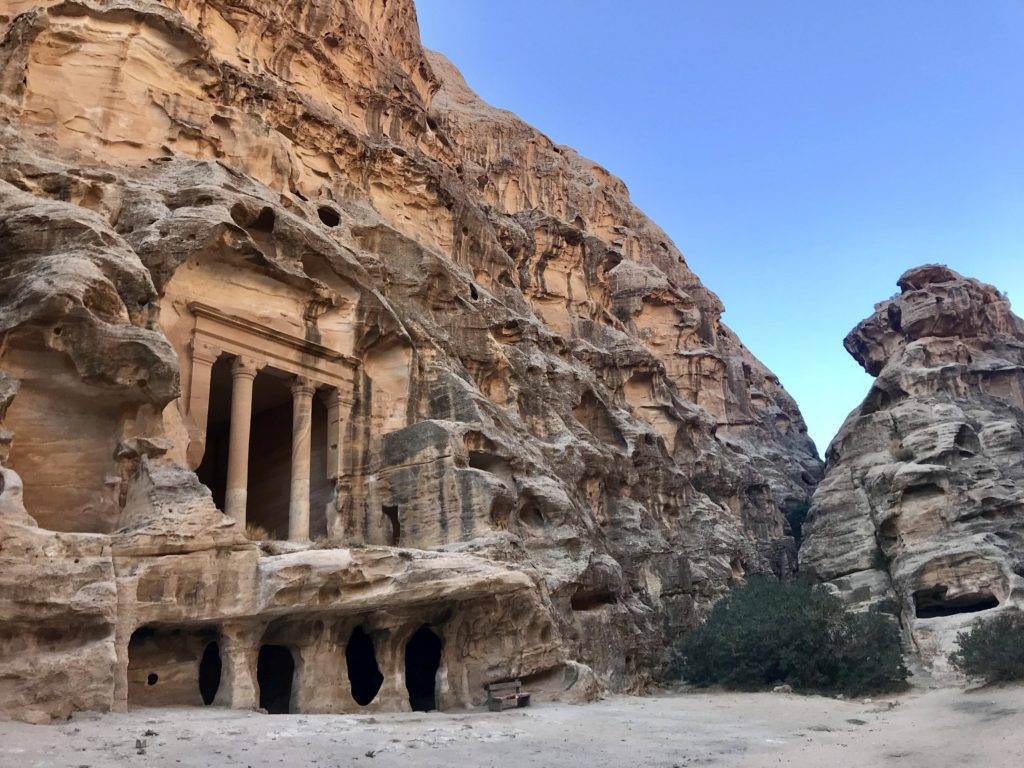
Little Petra is a short 15 minute drive north from Petra. It’s worth stopping by for a gander if you have a spare hour or two on your way to or from Petra.
As the name suggests, Little Petra is a (much much!) smaller version of Petra. You enter via a mini-Siq, explore a couple of rock-hewn monuments, and can take a short walk to see views of the valley. (Perhaps not the ‘best views in the world’, but you’ll see this sign several places around Petra and Little Petra!).
It only took us around 45 minutes to explore Little Petra. The highlight was the painted ceiling inside one of the caves, known as the Painted House. The paintings were only discovered in the 1980s and made public in 2000s. The Little Petra painted ceiling is the only surviving Nabatean wall paining. The frescoe has intricate floral motifs and cupid like figures, and is in very good condition.
Petra Itinerary – Day 1
By now, you should be all across the main sites of Petra and have a good idea of how to make the most out of your Petra tour. Here’s how we put that all together in an awesome 2 day Petra itinerary.
Key Details
Route and Key Sites: In the afternoon, walk the start of the Main Trail (Siq, Treasury), followed by the Al Khubtha Trail (Royal Tombs and Treasury from above) and Petra Church (afternoon). In the evening, join Petra by Night.
Time Required: Took us 4 hours for the afternoon and 2 hours for Petra by Night. Allow longer if you’re a slower hiker or like to linger at temples.
Hiking Distance: Around 18km – 12km for the afternoon and 6km for the night.
Afternoon – Siq, Treasury, Royal Tombs, Al Khubtha Trail
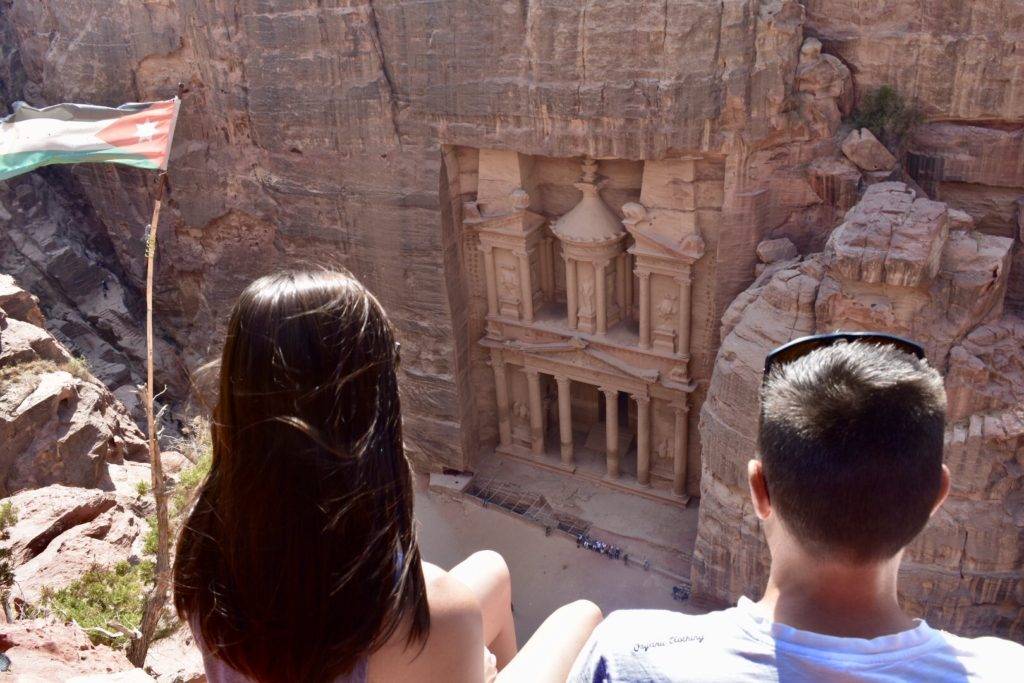
Aim to arrive in Wadi Musa mid to late morning, so that you have time to settle into your accommodation before hitting up Petra. We arrived at 11:45am to avoid the throngs of tourists who descend upon the Treasury in the morning.
After uncovering the delights of the Siq and Treasury, we decided to focus our first afternoon on the Royal Tombs and the uphill Al-Khubtha Trail. At the top of the Al-Khubtha trail, you should absolutely fork out 2-3JD for a drink at the local cafe and perch on the edge of the cliff with AMAZING views over Petra.
I was a little shocked (in a good way!) to find that there were only two people at the cafe when we arrived, and we even had the place to ourselves for a bit. When we set out on the Al-Khubtha Trail, I wasn’t actually aware that it ended with Treasury views, so I was pretty wowed when we arrived.
Evening – Petra by Night
After 4 hours of walking in the heat, we had a drink at the Cave Bar and returned to our hotel to relax. We went back for Petra by Night. Petra by Night runs every Monday, Wednesday and Thursday night from around 8:30pm to 10:30pm, and costs an additional JD17.
Petra by Night essentially involves walking the Siq lined by candles, and sitting outside the Treasury (also lined with candles) to watch the Petra by Night Show. While the official opening time is 8:30pm, we arrived at 8:10pm and walked straight in. This meant that the Siq was relatively quiet and we secured a good spot near the front of the Treasury.
Petra by Night gets very mixed reviews. It is very pretty and atmosphere with the Treasury lit up by candles and music playing. I’m glad we went, but for me it’s more a ‘nice to have’ rather than ‘wow’. You might get more out of the experience if you’re more ‘woo woo’ than me (as one of my friends would say) and into all that spiritual jazz.
It’s tricky to take photos that do it any justice (or in my case, even show the Treasury at all). Unless you’ve got the skills to pay the bills, I suggest just enjoying the serenity and atmosphere rather than getting frustrated with photos. We sat for an hour and soaked it all up, and then left early before the official show finished. Again, this mean that it was lovely walking through the Siq without the crowds.
Petra Itinerary – Day 2
Key Details
Route and Key Sites: Walk the full Main Trail (including round 2 of the Siq and Treasury, plus the Theatre, the Colonnaded Street and the Great Temple), followed by the Monastery Trail, returning via the High Place of Sacrifice Trail.
Time Required: Took us 7 hours at a reasonable pace with around 6 stops at cafes for drinks and snacks. Add longer if you want to have lunch in Petra, are a slower hiker, or like to linger at temples.
Hiking Distance: Around 17km. Exact distance varies depending on time walking around sites.
Morning – Main Trail and Monastery
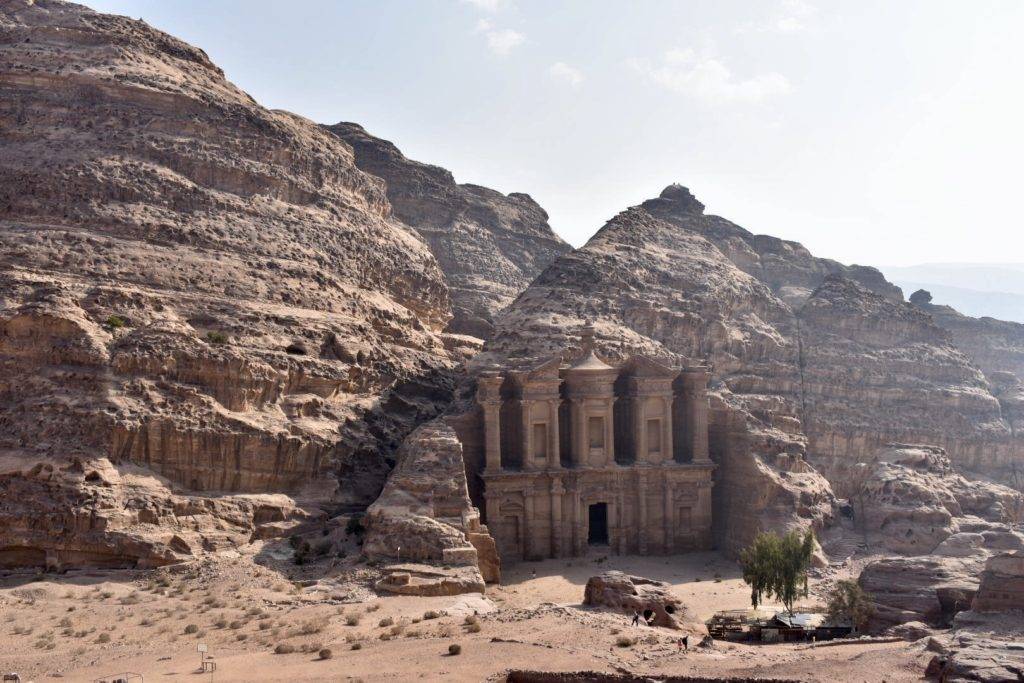
I recommend starting Petra Day 2 early. We arrived at the Visitors Centre at around 7am, so that there was some light as we walked through the Siq. We wanted to get to the Monastery before the crowds. Accordingly, we took a fairly direct route along the Main Trail to the start of the Monastery Trail. Along the way, we stopped at the sites we hadn’t seen on Day 1, including the Theatre and the Great Temple.
We started the Monastery Walk at 8:20am, and it took us just over 40 minutes including two drinks stops at little stalls. The walk itself is steep with many steps, but has beautiful views of the ancient city below to keep you going. The way people talk about it, I actually thought it would have been MUCH harder.
The Monastery itself is spectacular. Make sure you walk up the little hill behind the Monastery cafe to get the best views. We succeeded in beating the crowds! There were only a few people when we arrived at the Monastery around 9am.
If you’re an avid photographer, go in the afternoon for the best light. The Monastery was partly covered by shadows when we arrived. However, in my book, it was worth it to have the place virtually to ourselves.
Midday and Early Afternoon – High Place of Sacrifice
After walking back down the Monastery Trail, we took the High Place of Sacrifice Trail. It’s a long and sometimes steep walk to the top, with some great rock hewn structures to see along the way. We did this walk in the heat of the day, so it was a little exhastipating.
However, I’m so glad we took this route as it’s a lovely hike and has the best views over the ancient city below. Another plus is that not too many people take this trail, or only do the steep uphill (from near the Theatre) rather than the full trail.
After the High Place of Sacrifice, I was well and truly ready for a rest. I was very grateful to rest my legs with a cold mojito and late lunch at the Cave Bar!
Phew, what a meaty post! I hope my Petra tour guide, tips and hiking trails advice helps you plan an epic once in a lifetime trip to Petra. (Rather than my approach of close to zero planning and figuring it out as I went along!) Enjoy!
This post contains affiliate links. That means that if you click on a link, I may receive a small commission at no additional cost to you.
Like it? Pin it!
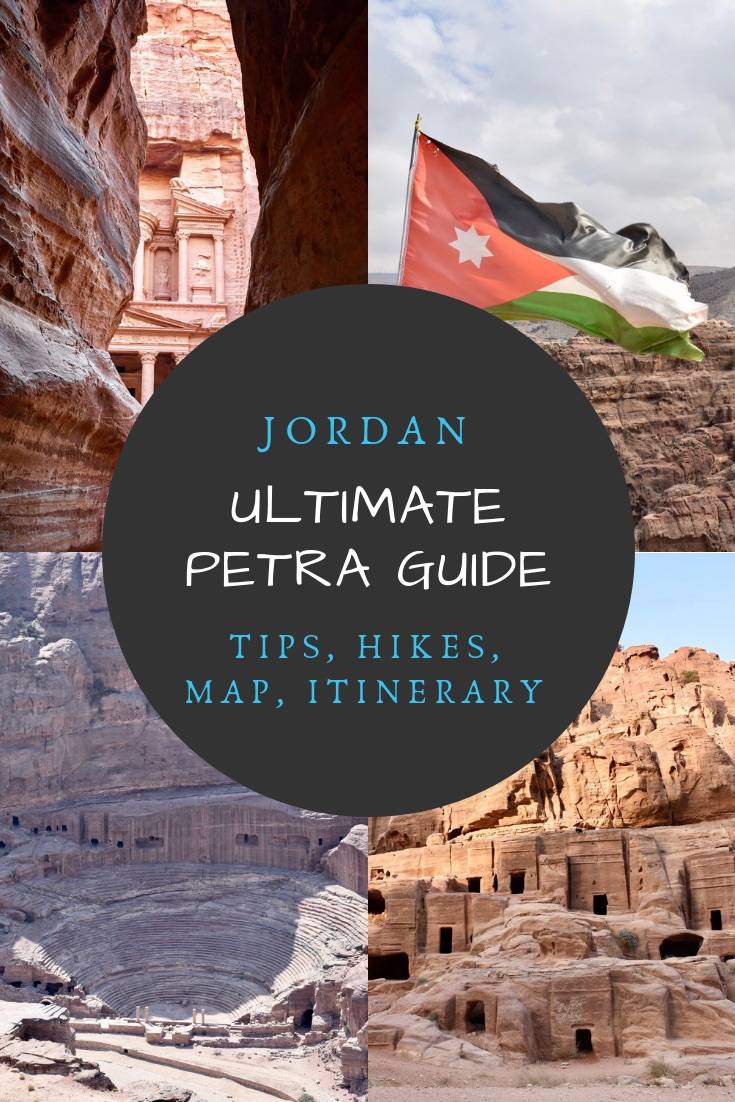
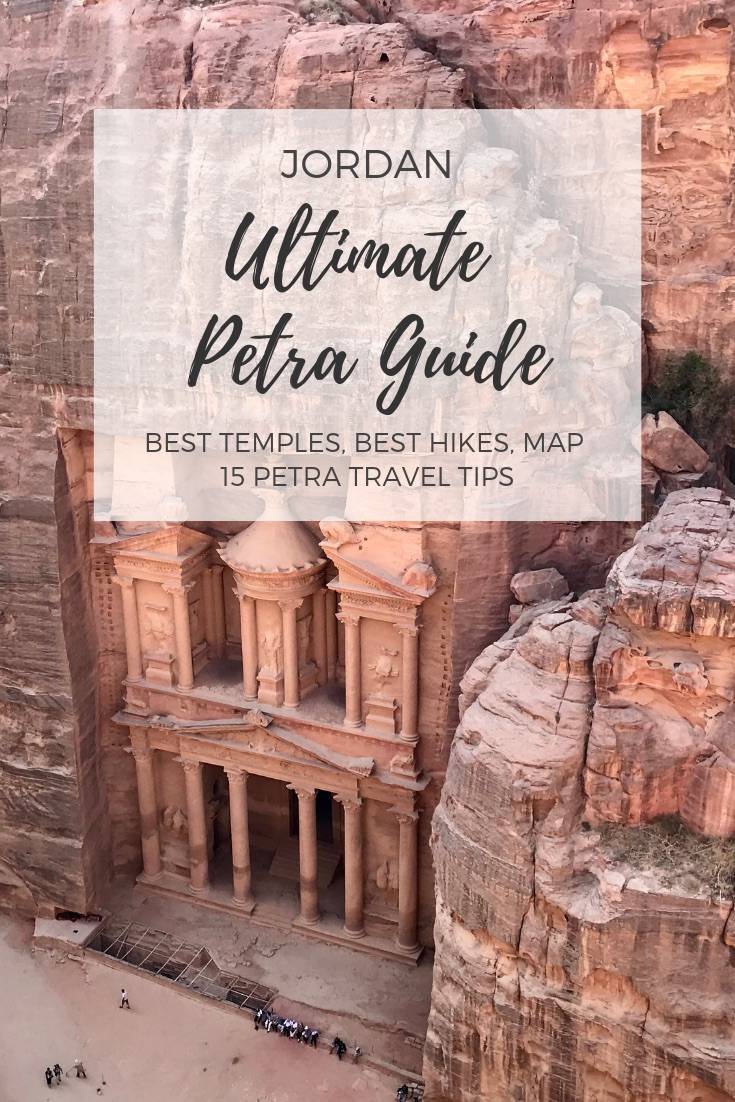
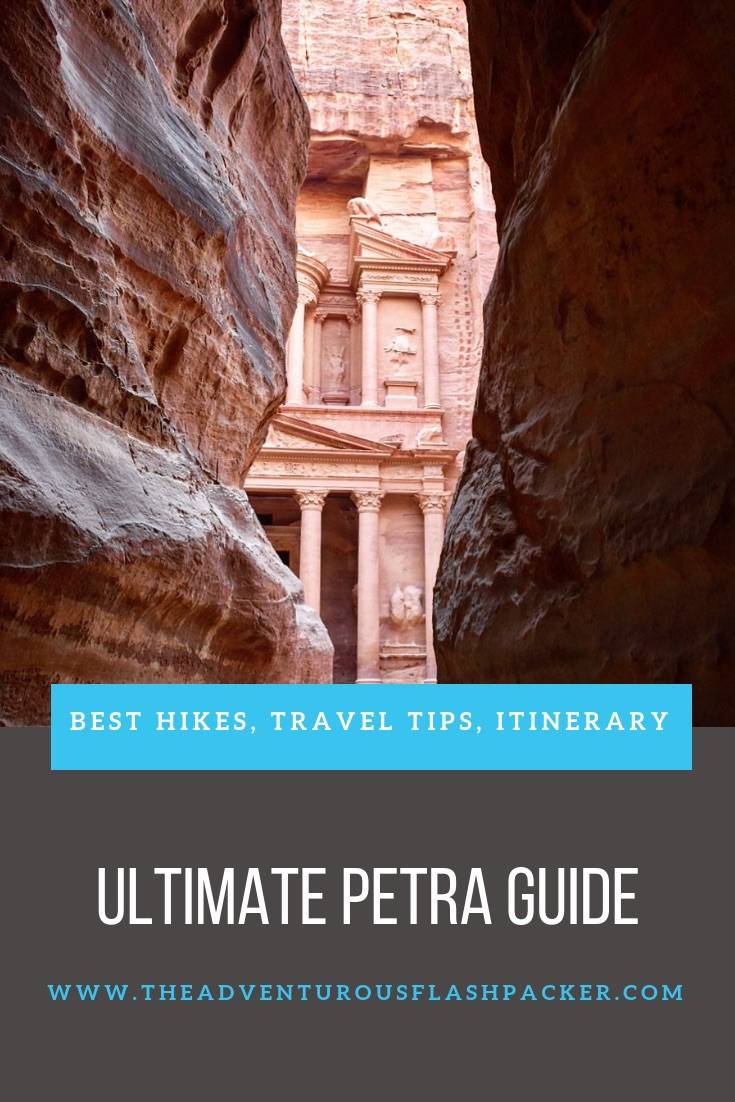

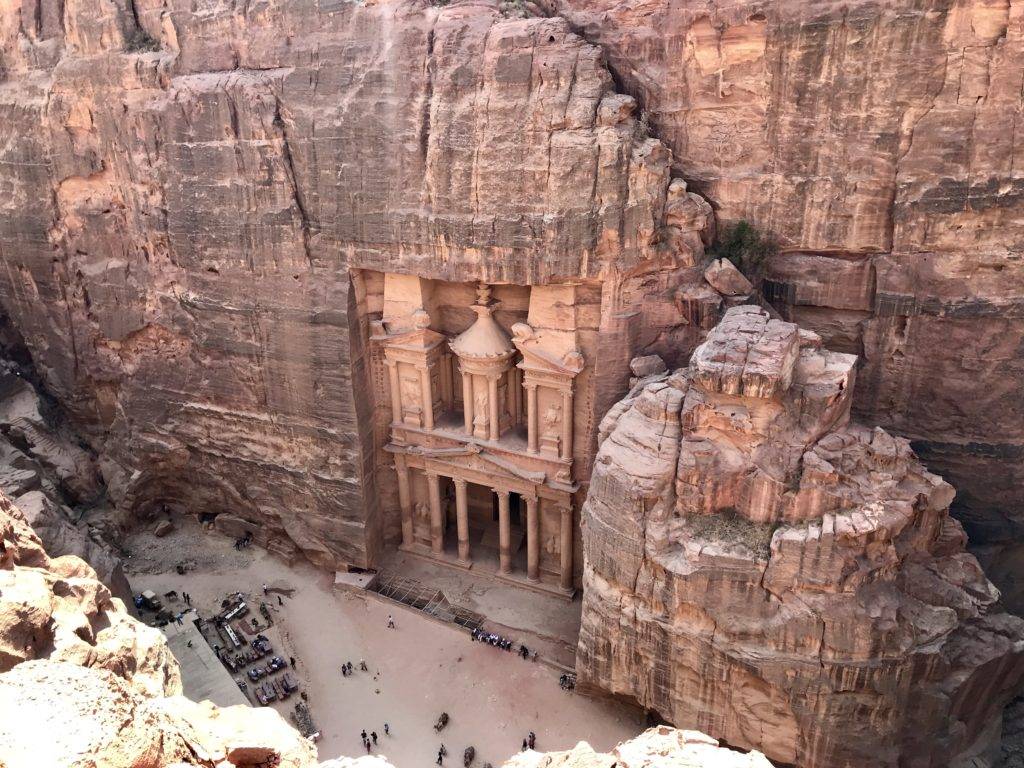

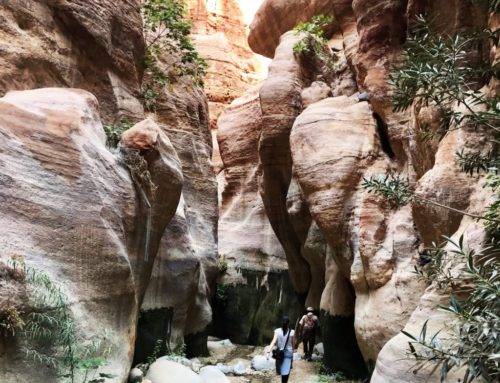
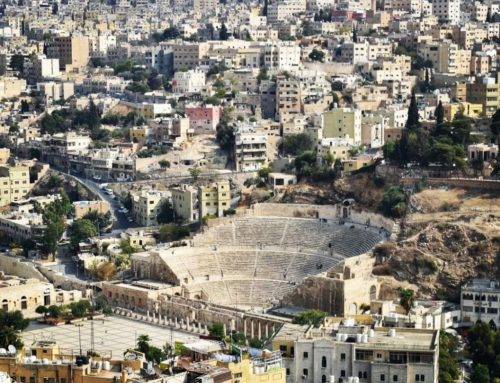
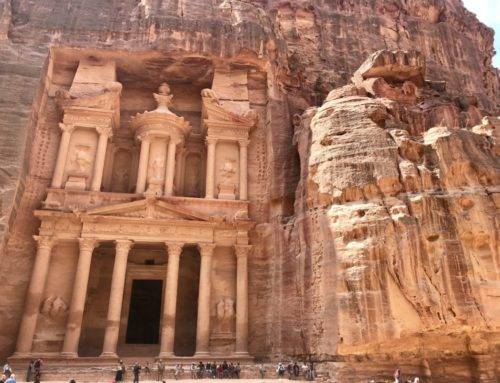
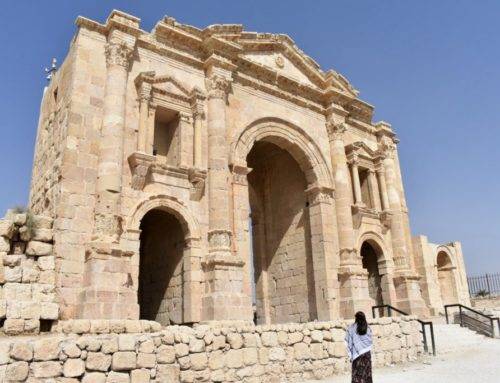
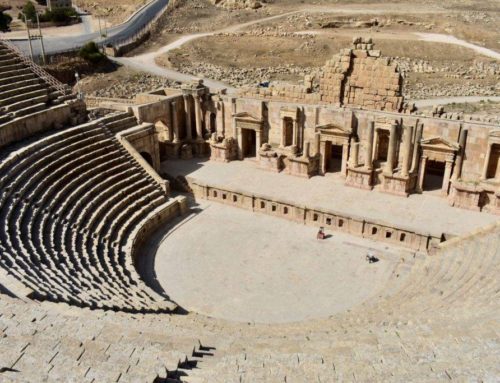
What a super handy guide to Petra! I’m going this March and am already super excited! I’m actually spending 3 days there – 2 days in Petra proper, and the first day I’m planning to do Little Petra and then do the back door hike to the Monastery. I was surprised to hear the cost of food and water at Petra. How much is a bottle of water once you’re in the site? Do they limit the size of backpack you can bring in? and, did you do Petra at Night? Would you recommend? thank you for sharing!
Thanks April! Glad you have three days there, it’s definitely worth staying for that amount of time, especially as the days can be long and exhausting. Yup, food and drinks are marked up, water I think was 1JD or so (although some places charge more, e.g. drinks usually more at the little cafes with amazing views) and we drank LOTS of it. I didn’t notice any limits on backpack size, we brought a regular sized day backpack and most people had backpacks with them – gets heavy if carry lots of water though. We did do Petra by Night … it gets really mixed reviews, but I’m glad we did it and would recommend it as it really is unique and pretty, if a little busy and touristy. We left before the light show started and it was lovely walking back through the siq without the crowds. Have fun!
Thank you! I have a 20L backpack that I use for nearly everything and didn’t know if Petra was like Machu Picchu where they limit the size of the pack. Good to know! I keep reading mixed reviews of Petra at Night but think I’ll give it a try anyways…I’m there, right? So why not. Thank you again for such a great, helpful guide!
Yup, you’ll be fine with a 20L backpack in Petra, that’s a pretty normal size day pack. I totally agree with you re Petra by Night – you might only visit once so I’d definitely go unless you’re on a really tight budget. Enjoy your trip!
The Royal Tombs and Monastery are gorgeous! Plus, I could definitely handle a drink at the cave bar after touring around. Sounds wonderfully authentic!
Gorgeous photos and such great info. I have been wanting to go FOREVER and need to make it happen soon. WIll definitely pin this for later:)
Thanks Cherene! Petra had been on my bucket list forever and I’m so glad we went, it was just as amazing as I hoped. Plus there’s so many other awesome sites to visit in Jordan!
Petra is an epic site, so it is no wonder this was epic ost lol. I am gutted I missed the cave bar when I was there, but then it was Ramadan so maybe it was closed. This was a great, thorough guide and it is making me want to go back!
I’m glad you loved Petra too! Epic is definitely the word to describe it. I did love the Cave Bar, nothing like a cold bevie in a unique bar after a long hot day’s hiking!
This is amazing! This is our bucket list trip for this year, and this has pretty much everything we need to know and have been wondering. Thank you so much for such a detailed post – saving this for when we go!
THanks Christine! Petra had been on my bucket list since forever, and it was one place that really exceeded my expectations – perhaps because I only really knew about the Treasury before I went and not all the other gems of Petra! Hope you get there this year and have an amazing trip.
This is such a fantastic guide on all the hikes! I’ve always wanted to get an idea of the different trails you could do in Petra to see the structures in the context of the broader landscape. This is exactly what I was looking for. Thanks!
Thanks Margarita! Yes, Petra is wonderful for hiking. I hadn’t actually realised that until we were there and checked out the maps (shoulda done more planning!) so I’m glad we left enough time to conquer a couple of the best trails.
Hoping to go next year and this is a really helpful, comprehensive post. The itinerary is particularly useful. Thanks!
Glad it’s helpful! You’ll love Petra, such a magical place.
A very good explanation of the trails. Thank You We leave in 2 weeks for 3 weeks of hiking in Jordan. We have planned to stay in Little Petra at a camp but if I had read this earlier I would have stayed in Petra. We will manage getting back and forth I am certain.
Thanks! Little Petra is not too far away so you should be find going into Petra and will enjoy having somewhere to retreat to at the end of the day. Your trip sounds amazing – enjoy!
great article. Question: in winter the site is supposed to close at 16.00pm. Does this mean that by 16.00, everybody is outside and doors are closed. What if somebody is still at the Monastery at 15.30?
Great question! In winter, the Petra ticket booth closes at 4pm but the site itself doesn’t close until sunset, which gives you another hour or so in Petra depending on the month. Check the sunset time and make sure you leave the Monastery in time to make it back to the entrance by sunset, and perhaps take a torch just in case!